Rapid changes in glutamate levels in the posterior hypothalamus across sleep-wake states in freely behaving rats
- PMID: 18815208
- PMCID: PMC2685298
- DOI: 10.1152/ajpregu.90541.2008
Rapid changes in glutamate levels in the posterior hypothalamus across sleep-wake states in freely behaving rats
Abstract
The histamine-containing posterior hypothalamic region (PH-TMN) plays a key role in sleep-wake regulation. We investigated rapid changes in glutamate release in the PH-TMN across the sleep-wake cycle with a glutamate biosensor that allows the measurement of glutamate levels at 1- to 4-s resolution. In the PH-TMN, glutamate levels increased in active waking (AW) and rapid eye movement (REM) sleep compared with quiet waking and nonrapid eye movement (NREM) sleep. There was a rapid (0.6 +/- 1.8 s) and progressive increase in glutamate levels at REM sleep onset. A reduction in glutamate levels consistently preceded the offset of REM sleep by 8 +/- 3 s. Short-duration sleep deprivation resulted in a progressive increase in glutamate levels in the PH-TMN, perifornical-lateral hypothalamus (PF-LH), and cortex. We found that in the PF-LH, glutamate levels took a longer time to return to basal values compared with the time it took for glutamate levels to increase to peak values during AW onset. This is in contrast to other regions we studied in which the return to baseline values after AW was quicker than their rise with waking onset. In summary, we demonstrated an increase in glutamate levels in the PH-TMN with REM/AW onset and a drop in glutamate levels before the offset of REM. High temporal resolution measurement of glutamate levels reveals dynamic changes in release linked to the initiation and termination of REM sleep.
Figures
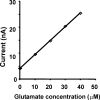


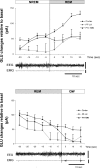
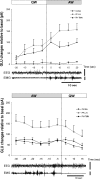
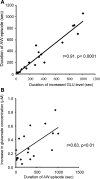

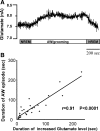

References
-
- Abrahamson EE, Leak RK, Moore RY. The suprachiasmatic nucleus projects to posterior hypothalamic arousal systems. NeuroReport 12: 435–440, 2001. - PubMed
-
- Albrecht J, Hilgier W, Zielinska M, Januszewski S, Hesselink M, Quack G. Extracellular concentrations of taurine, glutamate, and aspartate in the cerebral cortex of rats at the asymptomatic stage of thioacetamide-induced hepatic failure: modulation by ketamine anesthesia. Neurochem Res 25: 1497–1502, 2000. - PubMed
-
- Bettendorff L, Sallanon-Moulin M, Touret M, Wins P, Margineanu I, Schoffeniels E. Paradoxical sleep deprivation increases the content of glutamate and glutamine in rat cerebral cortex. Sleep 19: 65–71, 1996. - PubMed
-
- Brown RE, Stevens DR, Haas HL. The physiology of brain histamine. Prog Neurobiol 63: 637–72, 2001. - PubMed
Publication types
MeSH terms
Substances
Grants and funding
LinkOut - more resources
Full Text Sources
Other Literature Sources

